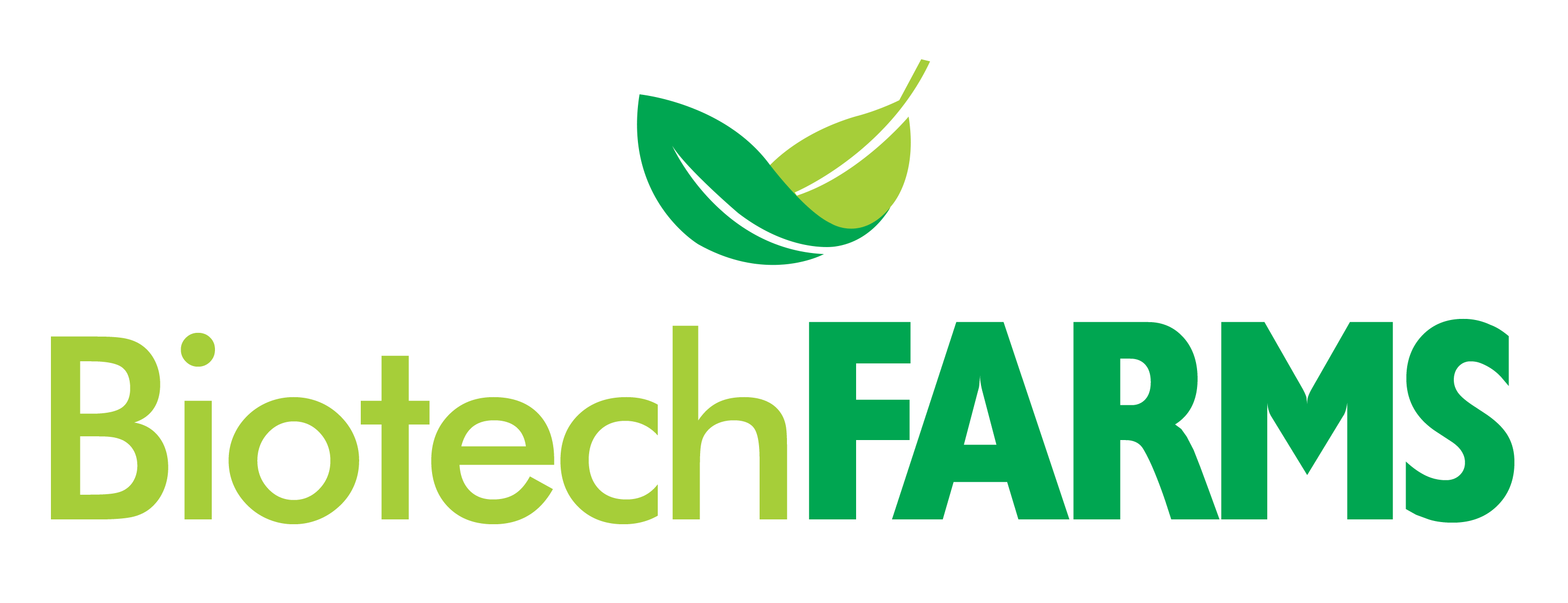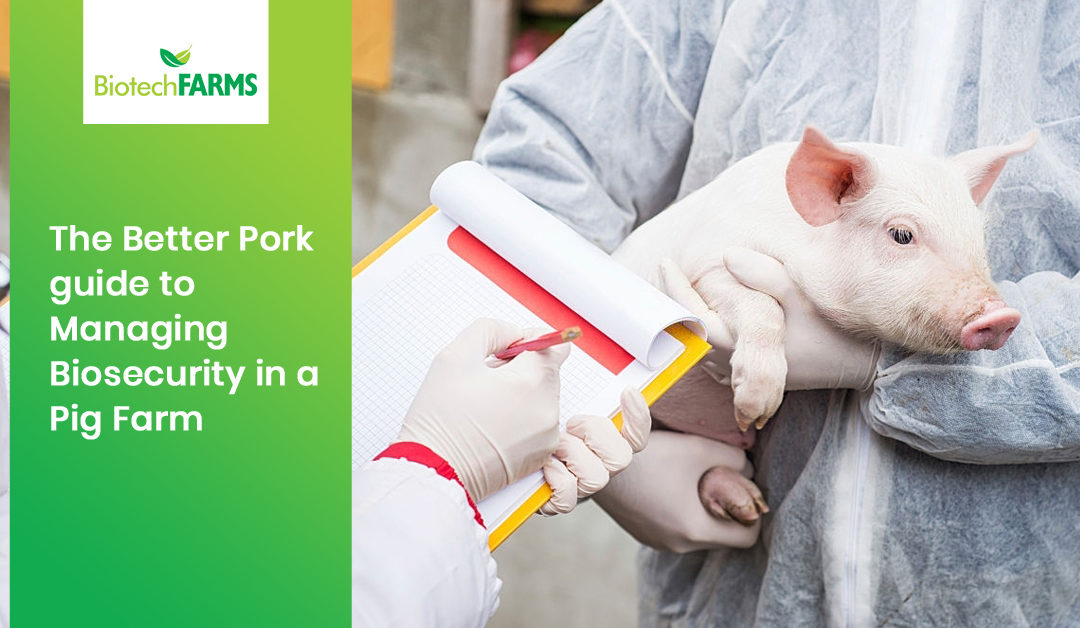The threat of the African Swine Fever (ASF) looms over the minds of pig farmers in the country. At this point, the swine industry knows that it is in everyone’s best interest to keep pigs as healthy as possible.
Besides the basics of keeping animals well-fed, watered, comfortable, and safe, it is equally important to keep pigs healthy by minimizing their exposure to disease-causing organisms.
So, why biosecurity?
This term has been gaining a lot of traction lately since the onslaught of the ASF virus in the Philippines. Biosecurity refers to all practices that keep diseases and disease-causing organisms away from a livestock population.
The goal of implementing a biosecurity program is to keep out pathogens that the herd has not been exposed to and to minimize the impact of endemic pathogens. Pig farm biosecurity can be defined as the implementation of a program to minimize risks that can have detrimental effects on the livestock population.
The Essentials of Biosecurity
Anytime pigs have contact with each other or even with people that have been around other animals, the opportunity exists for disease to spread.
Biosecurity is composed of three separate, but often blended, set of actions and overlapping components:
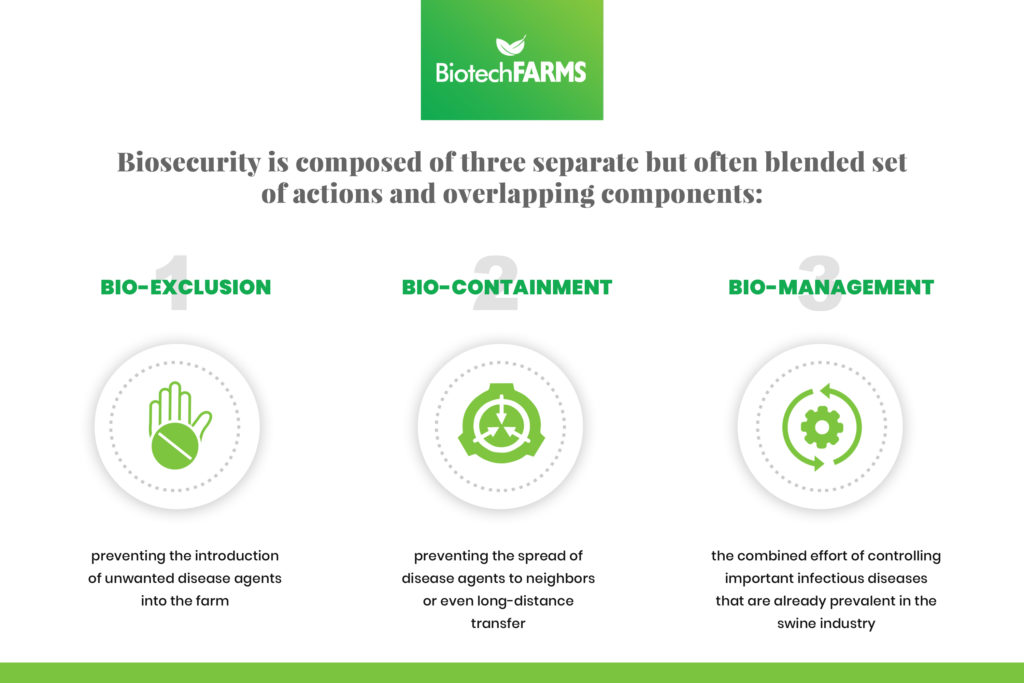
-
Bio-exclusion
This involves preventing the introduction of unwanted disease agents into the farm. This is where pig farms mostly keep their focus when it comes to biosecurity protocols.
-
Bio-containment
The purpose of bio-containment is to prevent the spread of disease agents to neighbors or even long-distance transfer. It also involves the essential aspects of protecting the food supply of consumers.
-
Bio-management
It involves the combined effort of controlling critical infectious diseases that are already prevalent in the swine industry. Room disinfection, vaccination, pig movements, and other procedures designed to reduce the disease pathogen level or enhance immunity levels are the key elements of bio-management.
The pig farms’ goals will determine how these three components are blended together into one cohesive biosecurity plan. Each of these components will significantly impact the economic viability of a pig farm in some areas of the Philippines.
As such, it is essential to understand that disease control is one of the most challenging endeavors for pig farmers. Pig farms aim to have minimal clinical disease status with their bio-management protocols. To develop a robust biosecurity plan, it is necessary to understand:
- the prevalence of diseases that can affect your herd;
- how each disease is transmitted;
- how each disease can be controlled;
- how to prevent each disease from entering the herd; and
- the potential cost of an introduction and outbreak.
Five facts every pig farmer should know about biosecurity

FACT 1: If it moves, it can carry diseases.
A pig farm’s biosecurity plan needs to encompass more than just the pig on the farm. It should also include the people working daily inside the farm. In addition, trucks and their drivers, facilities and equipment, employee vehicles, and clothing can all carry disease-causing organisms inside the pig farm. Thoroughly cleaning surfaces that will remove mud and other materials, disinfecting, and drying are just some effective steps that can reduce the amount of infectious organisms on surfaces inside the pig farm.
FACT 2: A person can be a vector for an animal disease even if it’s not “zoonotic.”
A zoonotic disease is an infectious disease that can spread between animals and humans. ASF and PEDv (porcine epidemic diarrhea virus) are just some examples of non-zoonotic diseases. While humans cannot be sick with ASF and PEDv, they can still transmit the disease from infected animals on their shoes, boots, or clothing. Washing, changing clothes, and using foot baths are just some of the simple ways that pig farms can control the spread of disease.
FACT 3: A man’s best friend (e.g., domesticated pets) can be an unwelcome companion on the farm.
Your beloved dog or other domesticated pets like cats are known to be faithful animals that follow their humans everywhere. Like people, these animals also tend to carry disease-causing organisms, even though they cannot get sick with it. Pig farmers need to have a “No Pets Allowed” Policy on the farm to minimize disease transmission risks.
FACT 4: Limiting traffic in the farms is one of the best measures to ensure biosecurity.
Having a single entry point inside the pig farm will help farmers keep an eye on the people who are coming in and out of the facility. It is recommended to post simple signs within the farm to remind people that biosecurity protocols are being implemented. It is critical that farm visitors need to be adequately instructed regarding biosecurity practices before entering the facility.
FACT 5: While implementing a biosecurity plan may be a significant investment, it’s not nearly as costly as losing some or all swine on a disease like ASF.
While implementing biosecurity protocols will not entirely ensure and guarantee that no disease can enter the farm, it can substantially reduce the risks. Think of a biosecurity plan as some sort of insurance policy, like an investment that a pig farm cannot afford not to put in place. Disease may still enter the most biosecure pig farm. However, it may be more easily contained and cause less financial impact than having no biosecurity plan in place at all.
Inside the Better Pork Facility

Better Pork’s commercial piggery production unit is composed of four different sections, namely:
Breeding & Gestation Section
This is the place where the gilts or sows are mated through Artificial Insemination. After conception, there is a gestation or pregnancy period, during which the pregnant sows are housed in individual gestation pens.
Farrowing Section
A week before the sows are ready to give birth, they are moved into an individual farrowing pen. During the farrowing period, the animal requires special care and attention.
Nursery Section
After weaning, piglets are moved to a nursery. They are housed with piglets from other litters. Better Pork’s nursery has specialized temperature control and ventilation to support the newly weaned piglets.
Grower-Finisher Section
After the nursery stage, the growing pigs are moved to a different facility called the “Gro-Fin” section. This is where the pigs will live until they mature enough to be sold to the market.
The Better Pork Way: Best Practices on Biosecurity
Better Pork upholds the highest standard of food safety with its biosecurity management program. The pig farm is protected with layers of biosecurity zone levels to restrict unnecessary movements in and out of the farm.
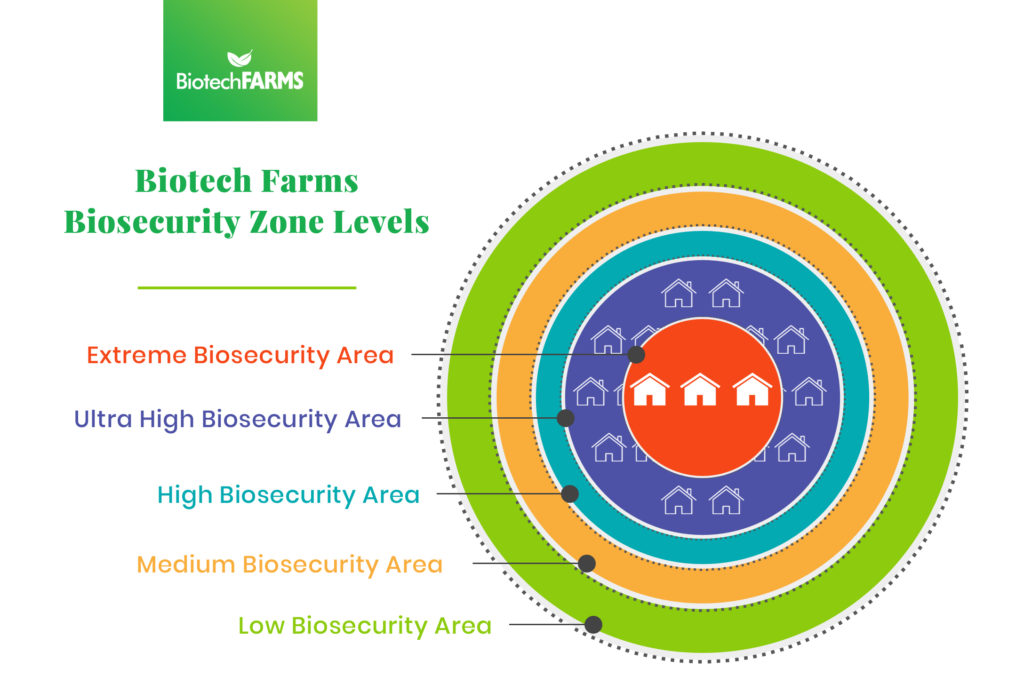
The pig farm is located in the heart of the Extreme Biosecurity Zone, where no one can enter without following a strict 14-day quarantine, foot and hand disinfection, full-body shower, and a complete change of clothes.
International and local entries are not allowed as of the moment due to its “Code Red” status. The company implemented its highest order of biosecurity control in response to the emerging threat of ASF. Production staff and veterinarians stay inside the Ultra High and Extreme Biosecurity Zones for a couple of months.
Each zoning location is equipped with different biosecurity protocols, namely:
Dirty Area
Marked white, the dirty area requires tire disinfection before entering back to an elevated biosecurity zone. Any area where mortalities and livestock waste are collected is identified as Dirty Areas.
Low Biosecurity Area
The low biosecurity area generally requires disinfectant misting, hand disinfection, and foot bath for human entry. It also requires truck wash and tire spray for vehicles.
Medium Biosecurity Area
The medium biosecurity area requires changing into the farm’s boots and another round of disinfectant misting, hand disinfection, and foot bath. Materials shall be subjected to UV radiation. Additional tire spray is required for internal vehicles entering from the low biosecurity zone.
High Biosecurity Area
The high biosecurity area generally requires personnel to undergo a full-body shower as they come in from the medium biosecurity zone. It is the third-highest level of Biotech Farms’ biosecurity zoning, and entry is highly controlled.
Ultra High Biosecurity Area
The ultra high biosecurity zone is the second-highest level of the company’s biosecurity zones. It covers the area enclosed by the perimeters of the swine farmhouse section. It also requires downtime or quarantine in the staff house and showering before entering.
Extreme Biosecurity Area
The extreme biosecurity zone is the highest level of the company’s biosecurity zones. It requires downtime in the staff house and showering before entering. This area also covers the nucleus or the swine breeder farm.
Here are several tips to help you start your own biosecurity plan:
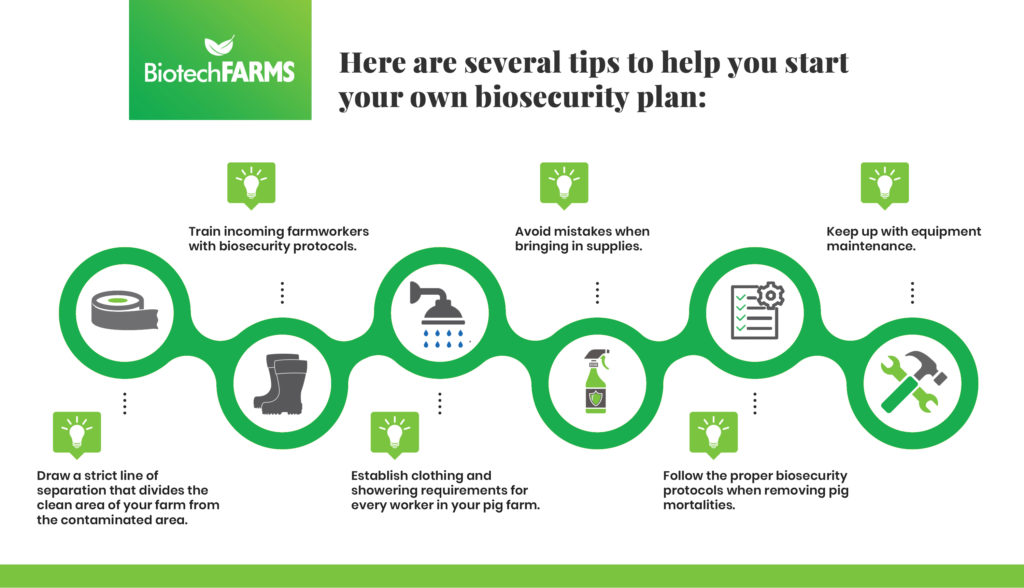
TIP 1: Draw a strict line of separation that divides the clean area of your farm from the contaminated area.
The first thing needed in a biosecurity plan is to designate a line of separation that divides a pig farm’s clean area from the contaminated area. Pig farmers need to be strict when it comes to maintaining farm hygiene. Visual reminders and posters, including painting door frames or designating areas with colored duct tapes, will help your farm personnel identify the clean and contaminated areas.
TIP 2: Establish clothing and showering requirements for every worker in your pig farm.
While a shower may not always be necessary at the onset of biosecurity implementation, a minimum standard is required to establish proper protocols such as changing into dedicated farm clothes and shoes before entering the facility.
TIP 3: Keep up with equipment maintenance.
Keep in mind that good equipment maintenance is essential to ensure a robust biosecurity plan. Ensure that feed is not spilling or building up in the bins since it can attract birds, rodents, and wildlife. The cost of regular maintenance helps avoid the entry of diseases.
TIP 4: Train incoming farmworkers with biosecurity protocols.
It’s a given that onsite workers need to be trained with biosecurity rules. However, occasional visitors like the vaccination crew, loadout crew, repairmen, and technicians can pose higher risks in the pig farm. It’s a good idea to brief these stakeholders ahead of time to explain the biosecurity protocols.
TIP 5: Avoid mistakes when bringing in supplies.
Using disinfectant rooms and UV chambers for incoming supplies are often common areas for mistakes. Remember that all surfaces inside the farm need to be exposed for disinfection.
TIP 6: Follow the proper biosecurity protocols when removing pig mortalities.
It’s essential to respect the clean and dirty area even when pig farms remove pig mortalities. Recognize the trucks and vehicles exposed to sick pigs and make the necessary arrangements for cleaning, drying, and disinfection.
Biotech Farms, through our Better Pork line, ensures the highest standard of food safety through biosecurity.
Adhering to their farm to plate philosophy, Biotech Farms delivers food without compromise. As part of our commitment to providing sustainably sourced food to every Filipino’s dining table, Biotech Farms takes food safety and security seriously.
To provide the best quality of pork to our Filipino customers, we consider biosecurity as an investment essential for the safety of animals, farmworkers, and the general public.
References:
Biosecurity – Pork Checkoff. (2021). Retrieved 8 April 2021, from https://porkcheckoff.org/pork-production-management/biosecurity/
Board, N. (2021). Biosecurity of Pigs and Farm Security – Pork Information Gateway. Retrieved 8 April 2021, from https://porkgateway.org/resource/biosecurity-of-pigs-and-farm-security/
The Five Things Every Livestock Farmer Should Know About Biosecurity. (2019). Retrieved 8 April 2021, from https://water.unl.edu/article/animal-manure-management/five-things-every-livestock-farmer-should-know-about-biosecurity
